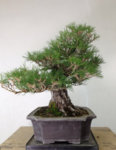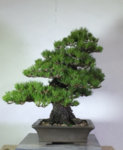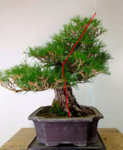I still am not sure what you mean by forward lean as you have not really commented nor taken the time like I asked to define it. My trees have forward leaning trunks, but do NOT have forward projecting apexes. I think there is a difference. And for the record, you have not defined what benefit this forward projecting apex adds to the forward image. Since you can't see it except from the side, you can't convey the same thing in a more upright normal looking way a tree grows image? If you don't know it nor see it , what purpose does it serve?
Foreshortening. It makes a longer trunk appear to be shorter than it actually is. You don’t “see” it, because it’s a visual trick. Our brains expect the tree to be growing straight up. When we see a vertical trunk, we really can’t tell if it leans forward, backward, or actually is straight up. Our binocular vision isn’t good enough to tell the difference. So, our brains assume that it is straight upright.
But, if it leans forward, the apex will not be as high above the pot. So, a forward leaning trunk will appear to be “shorter” than a trunk the same length if it were potted vertically.
So, for this tree:


The height above the pot is 23 inches. The length of the trunk plus the twigging to make the apex is 26 inches. A difference of 3 inches. That makes the tree 11.5 % shorter by having a forward leaning trunk than if it were potted upright.
As for the apex coming forward, we can magnify the foreshortening by increasing the angle of lean. Theorically, if the trunk came straight forward the viewer’s eye, it could be of any length and the tree would appear to be no taller, even though the trunk would be much longer. (Especially if the viewer were some distance away). Of course, that’s absurd, but the principle holds true.
Take a straight ruler, hold it straight in front of you at arms length, and observe the inch marks. Now tilt it so that the 12 is closer to your eye. Hold it at a 45 degree angle. Observe the inch marks. They appear to be closer together now. Tilt it more horizontal, the closer they appear to be. More vertical, they show their true length.
Using this trick, having an apex lean forward can make the internodes in the apex area appear to be closer together than they actually are.
So, the ideal way to take advantage of foreshortening is to have a trunk that increases its forward lean the higher up in the tree you go. Combine the foreshortening trick with actually having shorter internodes is what really makes for an outstanding tree. In my opinion, not using foreshortening is handicapping the artist’s ability to create an image of a large tree in miniature.











